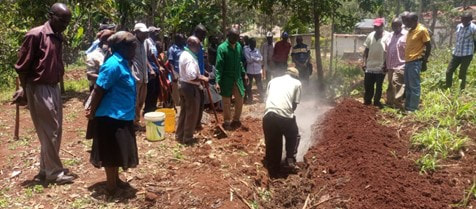Sowing the Seeds
| Paul Omollo implemented two of our permEzone pilot projects, founded FAR-EA (Farmers Alliance for Restoration- East Africa) as a new NGO, and is now overseeing the first post-pilot project that is being conducted by C-MRA (Community Mobilisation for Regenerative Agriculture) with the farmers in Kisumu West, Western Kenya. |
Paul recently updated us about the 3-month training that the 30 lead farmers in Kisumu West completed at the end of March. He confirmed that all 30 farmers completed the training, including a full permaculture design course, and that they significantly benefited from the practical sessions that were conducted at different farms, as this provided a diverse knowledge base as each site was unique with different resources.
The lead farmers have now embarked on the process of farm remodeling, farmer-to-farmer extension work, and community-building that C-MRA are supporting them with over the remaining 21 months of the project. Throughout this period, C-MRA will be tracking the changes that are taking place at each farm, and linking the farmers with other actors in the food systems value chain.
The lead farmers have now embarked on the process of farm remodeling, farmer-to-farmer extension work, and community-building that C-MRA are supporting them with over the remaining 21 months of the project. Throughout this period, C-MRA will be tracking the changes that are taking place at each farm, and linking the farmers with other actors in the food systems value chain.
| Meanwhile, we are happy to welcome Matt Innes to our team. Matt brings with him a vast experience working to improve the sustainability of food systems in different regions around the world, and is now starting the process of registering FAR as a nonprofit organization in the USA, and constituting the board of directors who will govern the new organization. |
We’ll bring you more news about FAR in the USA soon - including our plans for raising the funds we’ll need to support our work with many more farming communities – in East Africa and beyond – in the years to come.
We’ve created a special presentation about the outcomes of our three pilot projects, empowering farming communities to become their own best resources, and about our plans to build FAR’s capacity to extend this work far and wide over the coming years - you can view and/or download this presentation as a PDF from the permEzone website here.
We’ve created a special presentation about the outcomes of our three pilot projects, empowering farming communities to become their own best resources, and about our plans to build FAR’s capacity to extend this work far and wide over the coming years - you can view and/or download this presentation as a PDF from the permEzone website here.
Please donate to help fund the future of Farmers Alliance for Restoration.
Download as a PDF
Photos from the farmers training in Kisumu West...
Please share this newsletter, and encourage people you know to sign up for future newsletters to help us build on the success of the permEzone pilot and make this incredible program available to many more communities of farmers, so that they too can re-shape the future of their families, their farms, and their local economies.
Donations to fund future projects in East Africa are always welcome HERE.
Donations to fund future projects in East Africa are always welcome HERE.









 RSS Feed
RSS Feed